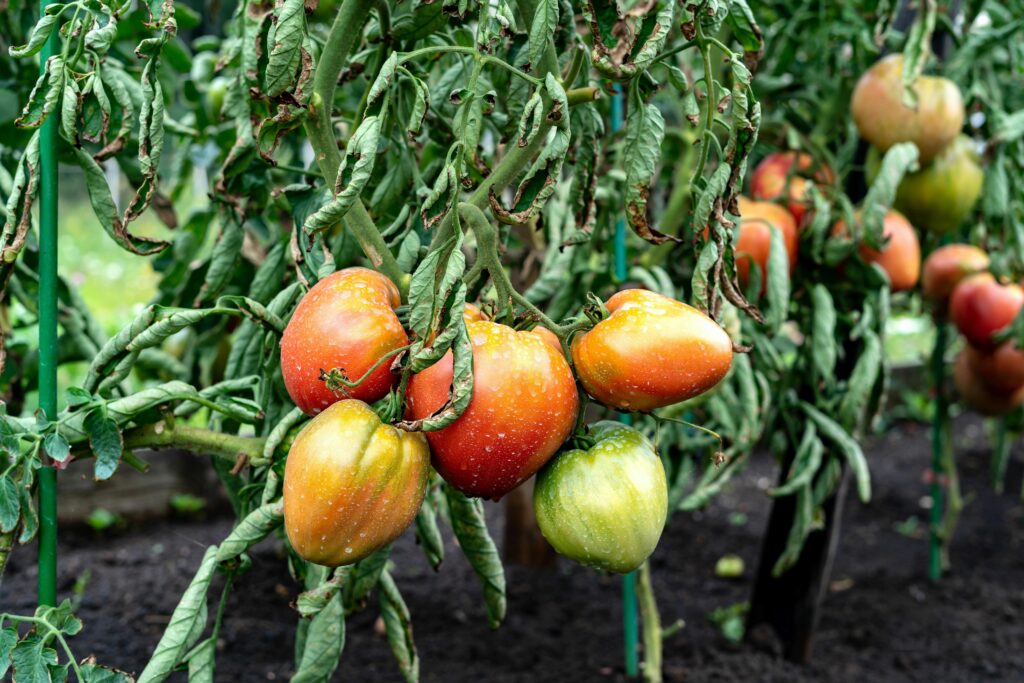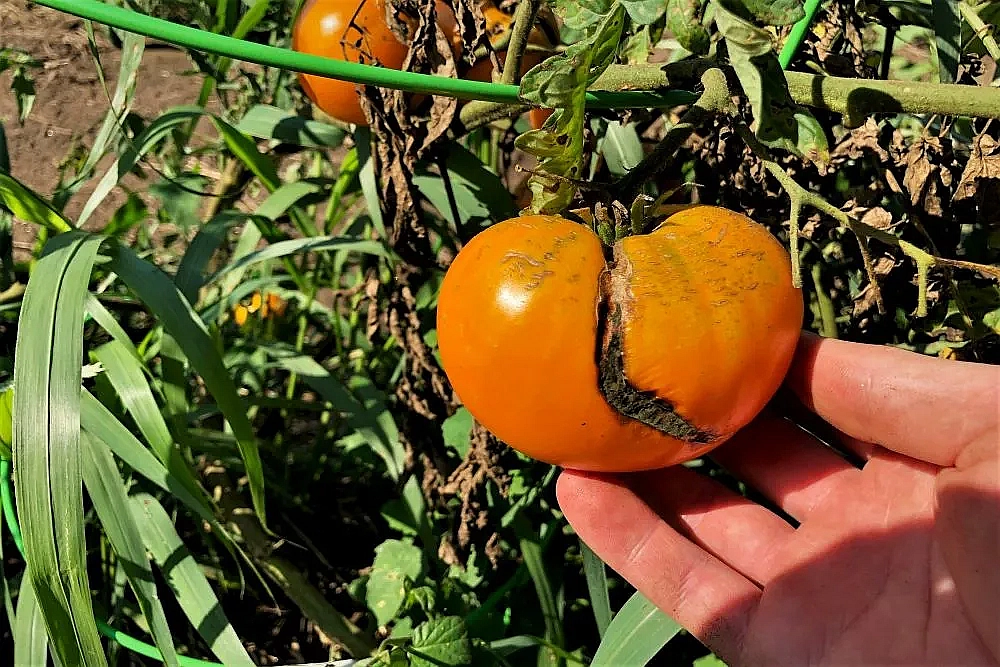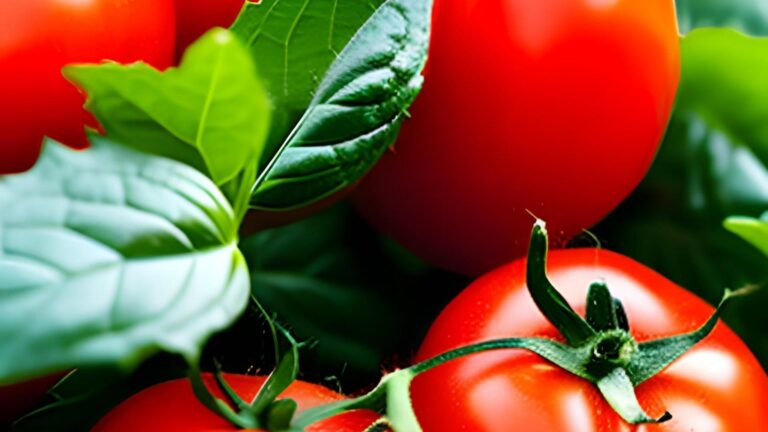In This Article
Key Takeaways
– 🌡️ Hot weather can cause wilting in tomato plants, as the high temperatures lead to drooping leaves.
– 💦 Underwatering is a common cause of wilting, and it is important to water plants before wilting occurs to prevent damage.
– 🌱 Improper hardening off, or gradually acclimating indoor plants to outdoor conditions, can result in wilting and sun scald of tomato leaves.
– 🐛 Borer insects, such as tomato hornworms, can burrow into stems and fruits, causing wilting and damage to the plant. Mulching and using natural insecticides can help prevent infestations.
– 🌱 Wilting diseases like Verticillium Wilt, Fusarium Wilt, and Southern Blight can infect tomato plants and cause wilting. Disease-resistant tomato varieties can help prevent these issues.
– 🐛 Pests like tomato hornworms and aphids can also cause wilting by feeding on the plant’s sap. Regular inspection, manual removal, and organic insecticides or natural predators can help control pests.
– 🌱 Planting incompatible companion plants near tomatoes, such as Brassica family members or potatoes, can increase the risk of wilting. Proper companion planting guidelines should be followed.
– 💡 Tips for preventing wilting include pruning sucker shoots, bottom pruning, mulching, ensuring good airflow, planting disease-resistant varieties, and maintaining overall plant health.
– 💚 Wilting can be reversible if the cause concerns water stress or environmental factors. However, recovery might be difficult if it is due to a disease or pest infestation.
Top Reasons For Wilting Tomato Plants and Effective Solutions
One of the most common issues observed in growing tomatoes is the occurrence of wilted leaves. Consequently, one frequently asked question concerning tomato plants is, “What is the reason behind the wilting of my tomato plants?”

Today, I will discuss the various causes of tomato leaf wilting, including environmental factors, diseases, and pests. I will begin with the most probable causes and conclude with less common factors contributing to the problem.

1. Hot Weather
The weather in New England varies significantly throughout the growing season, with unseasonably cold weather in May and early heat waves in June. During unexpected hot spells, wilting leaves are commonly observed.
During periods of excessive heat, when temperatures rise above 90°F (32°C), tomato plant leaves may start to wilt. One of the ways plants protect themselves is by drooping their leaves, which decreases the amount of sunlight they are exposed to.
The effect of wilting leaves on a tomato plant is a decrease in overall temperature, which can help reduce stress and maintain the plant’s health and strength during hot weather. In a way, wilting leaves indicate that the plant responds appropriately to high temperatures.
Solutions
Although the solution may appear straightforward (waiting for the weather to cool down), I take a few measures for my tomatoes during scorching weather.
- Move potted plants to partial shade. During a heat wave, if your tomatoes are in containers, move them to a shaded spot. Shade can lower the plant’s temperature by reducing the solar radiation it absorbs. This works best from 2-4 PM, the hottest part of the day.
- Spray your plants with cool water. Running water is typically cold because of underground piping. Although I don’t usually suggest it, occasionally, I spritz my plant’s leaves with cold water to provide quick relief from the heat. Watering should always target the base of the tomato plants. However, if your plants are excessively stressed from heat, a swift remedy would be to spritz the foliage with clean, cold water.
Wilting tomato leaves are expected during the hottest months of the year, mainly when your plants are hardening off-stage.
2. Under-Watering
Dry soil is a common cause of wilted tomato leaves. This happens when the plant needs water. Some plant varieties may wilt their leaves to preserve water when they are underwatered.
After being watered, a dehydrated tomato plant will regain its vigor within an hour or two. However, it is advised not to intentionally let your plants wilt before watering them.
It is recommended to water plants before wilting occurs, as the alternating cycle of dry and wet soil can result in cracked tomatoes and blossom end rot.

During hot weather, plants like tomatoes require more water due to increased transpiration through the leaves. It is recommended to water them before wilting occurs to prevent damage.
If watering the tomatoes does not revive them, further investigation will be needed to determine the cause.
3. Improper Hardening Off
If you choose to grow your tomatoes from seed, it is common practice to start them indoors to extend the growing season. Consequently, your plants will eventually need to be moved indoors to outdoors.
Tomatoes are sensitive to changes in light exposure, and moving them outdoors too quickly can result in sun scald and wilting of the leaves. Following a guide for adequately hardening off tomatoes is advisable to prevent this.
Acclimating indoor plants to outdoor conditions involves gradually exposing them to direct sunlight, wind, and precipitation. Starting this process on a cloudy day or in a shaded area is recommended. After 20-30 minutes of outdoor time, the plants should be brought back indoors, and the process can be repeated the next day.
After a period of cloudy weather, it is recommended to gradually expose the plants to sunlight, starting with 15-20 minutes and increasing by 20-30 minutes each day until they are fully acclimated.
It is essential to take your time when hardening off plants. This process may require effort as you move them in and out daily, but it will help prevent sun scald and plant stress, resulting in more extensive and healthier plants.
4. Borer Insects
In the enchanting world of tomato plants, tiny creatures are known as “borers.” These mischievous insects have a penchant for burrowing into the stems and fruits of tomatoes, wreaking havoc along the way. If you ever come across wilted tomato leaves or discover minuscule punctures in the stems, chances are these little rascals are to blame. Brace yourself for the secret life of the tomato borers!
Borers use plants as hosts to lay and feed their larvae. To tackle this problem, why not give your young tomato plants a cozy mulch blanket?
This simple trick will keep those pesky insects from turning your lower branches into a nursery for their larvae. So go ahead and give your plants some much-needed protection!
As the plants grow, the mulch can be removed or left for improved water retention. You can slit the stems vertically and remove the bugs to remove insects from your plant. Although not enjoyable, this method can prevent additional damage caused by insects.
There are natural insecticides available that can help decrease populations and make tomatoes less appealing to borers. A neem oil solution can be sprayed on garden plants to suffocate adult insects and disrupt their life cycle. This method can also be effective against aphids and other sap-sucking pests.
5. Wilting Diseases
Several diseases can cause tomato foliage to wilt, such as Verticillium Wilt, Fusarium Wilt, and Southern Blight.
- Verticillium Wilt is a soil-borne pathogen commonly found in temperate regions worldwide. It can be a significant issue if plants are watered incorrectly. Watering tomato plants at their base is advisable to prevent soil from splashing onto the leaves.
- Fusarium Wilt causes wilting and displays distinct symptoms compared with other diseases. Infected plants often exhibit one-sided yellowing on the leaf branches, which can also affect one side of the plant.
- A soil-borne fungus causes southern blight and can potentially destroy entire tomato plants. It is more prevalent in hot weather and has a slower spread rate during cooler autumn.
Tip: Plant disease-resistant tomatoes to avoid these issues in the first place.
When dealing with plant diseases, it is essential to identify specific symptoms beyond wilting to diagnose the problem accurately. Additionally, it is worth considering the potential influence of regional factors, as certain diseases may be more prevalent in specific areas.
Solutions
If you are experiencing issues with your tomatoes, it is essential to rule out other potential causes before assuming it is a disease. Confirming a disease’s presence is crucial to address the problem effectively.
After confirming the disease, it is recommended to dispose of the entire plant, as most pathogens can be transferred between plants.
Tomatoes can spread diseases to other garden crops, like peppers and squashes. But don’t worry, there’s more to it! Let’s dive into a more enjoyable and unique way of viewing it.
6. Pests
Tomato plants can often suffer from various pests that can cause wilting. One common pest that affects tomato plants is the tomato hornworm. These large green caterpillars can devour tomato leaves and stems, leading to wilting and overall plant decline. Another pest to watch out for is the aphid, which feeds on the sap of tomato plants and can transmit diseases that cause wilting.
To effectively address pest infestations, it is important to inspect plants for signs of pests regularly, manually remove them when possible, and use organic insecticides or natural predators like ladybugs to control their populations.
7. Bad Companion Plants
Some plants can hurt tomato plants when grown together, leading to wilting and other issues. For example, planting tomatoes, such as cabbage or broccoli, near Brassica family members can attract pests like cabbage worms, which can damage tomato plants. Similarly, planting tomatoes near potatoes can increase the risk of blight, a fungal disease that causes wilting and foliage damage.
To avoid these problems, it is important to research and follow proper companion planting guidelines, ensuring that tomatoes are not planted near incompatible plants that can contribute to wilting.
Tips For Preventing Disease In Tomatoes:
Here are some tips for preventing disease in tomatoes.
- Prune sucker shoots. Pruning tomatoes is vital for healthy plants. I prune sucker shoots as soon as they are ready for indeterminate varieties. I leave them on for determinates to maximize the harvest. Find more information on pruning tomatoes here.
- Bottom pruning is beneficial for all types of tomatoes. It involves removing the lowest branches from the plant. This prevents soil from splashing onto the foliage during rain or irrigation. I do this every year.
- I like to mulch my tomato plants to prevent soil splashing. Mulching helps dampen the fall of rain and prevents soil-borne pathogens from reaching the leaves. I use straw or grass clippings as a simple and affordable mulch.
- To improve airflow, you can’t completely prevent spores from landing on your tomatoes. But you can create an environment that is less conducive to pathogens. Pathogens thrive in moist, stagnant air, so avoiding this around your tomato plants is essential. The simplest way to achieve good airflow is by spacing your plants properly and pruning unnecessary foliage.
- You can plant disease-resistant tomato varieties to simplify the issue. There are many confirmed disease-resistant types of tomato available. Plant breeders and scientists continually improve plant varieties to reduce these issues for commercial growers. Fortunately, home gardeners can also benefit from these advancements.
Dealing with diseased plants can be disheartening, especially after investing months of care. However, I consistently maintain a positive outlook and focus on implementing preventive measures for the following year.
Will Wilted Tomato Plants Recover?
Various factors can cause wilting, and recovery will depend on the symptoms. Environmental factors are the most common causes of wilting, so making simple changes can help plants regain their health.
Generally, wilted tomato plants can recover if the cause is underwater or in hot temperatures. However, if the wilting is due to disease, it will not recover and may worsen if not addressed promptly.
If you can revive your wilted tomato plant, taking measures to prevent it from happening again is recommended. Wilted leaves, regardless of the cause, indicate plant stress. It is advisable to ensure the well-being of your tomatoes at all times.
FAQs About Wilting Tomato Plants:
1. What are the common reasons for wilting tomato plants?
Wilting tomato plants can result from several factors, such as overwatering, underwatering, diseases like Fusarium wilt or Verticillium wilt, or pest infestations. A thorough inspection is needed to identify the exact cause.
2. How can I effectively treat wilting tomato plants?
The treatment for wilting tomato plants depends on the cause. It could range from adjusting watering habits to improving soil health to treating for specific diseases or pests. Consulting with a local extension service can be helpful.
3. Can overwatering cause tomato plants to wilt?
Yes, overwatering can indeed cause wilting in tomato plants. This is because excessive water in the soil can lead to root rot, which hinders the plant’s ability to take up water and nutrients, leading to wilting.
4. How can underwatering lead to wilting in tomato plants?
Underwatering leads to wilting because it causes the plant to become dehydrated. The plant’s cells cannot maintain their structure without sufficient water, causing it to wilt.
5. What diseases commonly cause tomato plants to wilt?
Common diseases that cause wilting in tomato plants include Fusarium wilt, Verticillium wilt, and bacterial wilt. These diseases infect the plant’s vascular system, hindering water and nutrient uptake.
6. Can pests cause wilting in tomato plants?
Certain pests like aphids, whiteflies, and spider mites can cause wilting in tomato plants. These pests feed on the plant’s sap, which can lead to dehydration and, subsequently, wilting.
7. How does soil health impact the wilting of tomato plants?
Soil health greatly impacts plant health. Nutrient-rich, well-drained soil allows roots to access the water and nutrients they need. Poor soil conditions can stress the plant, leading to wilting.
8. What preventive measures can reduce the risk of wilting in tomato plants?
Regular watering, maintaining good soil health, using disease-resistant varieties, and timely pest management can help prevent wilting in tomato plants.
9. Is wilting in tomato plants reversible?
Depending on the cause, wilting can be reversible. If it’s due to water stress, adjusting watering habits can help. However, recovery might be difficult if the reason is a serious disease or pest infestation.
10. What role does temperature play in the wilting of tomato plants?
Extreme hot and cold temperatures can cause wilting in tomato plants. They prefer temperatures between 55-85 degrees F. Maintaining optimal temperature is key to preventing wilting.
Are You New To Tomato Answers?
If you are new to Tomato Answers, then here are a few resources that will help you:
- Craving for some Celebrity Tomatoes? Find out what makes it so special! – Celebrity Tomato
- Looking for the perfect tomato sauce recipe? Try this Instant Pot version! – Instant Pot Tomato Sauce Recipe
- Growing tomatoes: The Dos and Don’ts you need to know! – Growing Tomatoes: Dos and Don’ts
- How much does a pint of cherry tomatoes weigh? Find out here! – How Much Does A Pint Of Cherry Tomatoes Weigh?
- Master the art of growing tomatoes from seeds! – How To Grow Tomatoes From Seeds?
- Uncover the secret to tell if a tomato flower is pollinated! – How To Tell If Tomato Flower Is Pollinated?
- Are pesky tomato bugs ruining your crop? Find the solution here! – Tomato Bugs
- When is the best time to harvest your cherry tomatoes? Find out here! – When To Pick Cherry Tomatoes: Harvesting Tomatoes
- Why did the tomato blush? Uncover this charming riddle! – Why Did The Tomato Blush?



